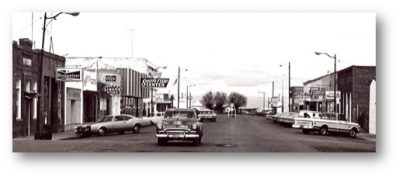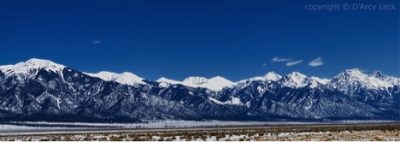
Main Street in Small Town America
My Home Town: No Radicals. No Protests.

Center, Colorado: A one stoplight town
Terry, supplement to A Rendezvous to Remember, Ch 14: High-Stakes Gambling
I spent my formative years in Small Town America – on a farm three miles outside of Center, Colorado, an isolated town of 1,600 people. Our crops: spuds, barley, and alfalfa. Sheep, no cattle.
Out-of-the way Center: 220 miles south of Denver in the sprawling 7,500-foot high San Luis Valley. 1950 census – 2,400. 1960 census –1,600. 1970 census – 1,379. Small town – and declining.
Our high school had 200 students. A whopping 36 in my graduating class, 1959.
Small Town America: High Poverty, Limited Opportunities
Center was a pocket of poverty. In 1960, Center’s average per capita annual income was $1, 669 – at a time when Colorado’s was $3,070. High unemployment. Worse underemployment. High percentage of substandard housing. One physician in our small town – and for the surrounding 2,000,000-acre county; no dentist. Unless papa owned a farm (and fewer and fewer papas did), most young people left after high school. I was one of them.
Center had a two-block business district and a single traffic signal. For entertainment we had a pool hall on Main Street, a drive-in movie three miles out of town, an annual rodeo, the 4thof July parade, and the annual VFW Thanksgiving Turkey Shoot (bring your own shotgun). One restaurant: a diner with 10 stools.
Two Communities: Haves and Have-nots
Those are the bare facts. But in reality, Center was two communities – one Chicano (58% of the total population); the other Anglo, 42%. No Blacks. No Asian-Americans or Native-Americans. One family of Lebanese descent. Only a handful of Center’s Chicanos had been born in Mexico. Most were descendants of the Conquistadors who settled Santa Fe in 1607. Over the centuries, those families slowly migrated up the Rio Grande River into southern Colorado and established small communities in the foothills on both sides of the San Luis Valley.
In the early ’60s, educational achievement for Center’s Chicanos was among the lowest in the state. In my graduating class, only 8 of the 36 were Chicanos. Of the town’s Chicanos, only 11% had completed high school.
Through the ’50s and early ’60s, Anglos ran the town. They owned all the businesses, and had all the good jobs. The mayor, the town councilmen (all were men), the school board, every county commissioner, all the school teachers, the sheriff, his deputies, the policemen, the volunteer firemen, every member of every official body was an Anglo. No Chicanos. None.
Chicano Housing at Bottom of Heap – and Segregated
In those days, housing for Chicanos was at the bottom of the heap in Colorado. In 1960, 60% of Chicano homes in Center were valued at less than $5,000 — compared to 20% for Anglos, and 3% of all homes statewide. As late as 1965, a quarter of Chicano homes in Center relied on outhouses – compared to 2% of Anglo homes.
And, in those days, the town was segregated: Chicanos lived in their own barrio on the east side of town – between the railroad tracks and “Main,” the street that ran through the heart of the two-block business district. Every Anglo family lived west of Main. On the Anglo side of town: paved streets lined by curbs, gutters and street lights. In the barrio: it was all dirt streets; not a single sidewalk.
Small Town America: Peaceful and Serene – or a Sleeping Giant?
In spite of these dismal statistics, the place was an oasis of peace surrounded by farms – no major crime, no criminals, no drugs, no brothels or dens of iniquity. And despite the conditions, no radicals in those days. No protests, no confrontations – though the protests, as well as major changes, would come in spades in the late ’60s and early ’70s, well beyond the years covered in our memoir.
We also had breathtaking daily views of the magnificent Sangre de Cristo mountain range to the east, and the San Juans to the west.
In retrospect, it’s remarkable how little I knew about my hometown as a high school kid. I didn’t understand the depths of poverty, the extent of racism and discrimination. Now, though, I do. Want to feel what it was really like? Read my novel, Soda Springs: Love, Sex, and Civil Rights. Not accidentally, the fictional town of Soda Springs is strikingly similar to Center in the 1960s.

Sangre de Cristo mountain range along the San Luis Valley’s eastern perimeter

Sign Up for News Flashes
Please keep in touch! And to be notified for events around A Rendezvous to Remember and other news from us, please sign up. Our promise? We won’t sell your address to anyone or clutter up your inbox with junk.




